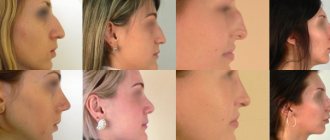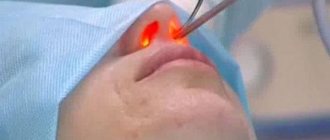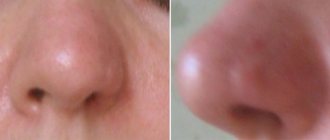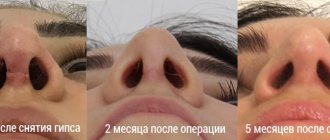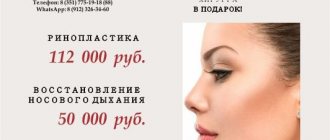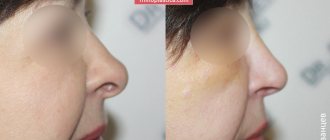There are contraindications. Specialist consultation is required.
The correct position of bones and cartilage ensures the normal functioning of the upper respiratory tract. Repositioning of the nasal bones during a fracture is a procedure to restore displacement of the cartilage and bones of the nose resulting from trauma or congenital pathology.
Causes and symptoms
In the absence of adequate medical care, nasal deformations can lead to persistent impairment of nasal breathing and impaired sense of smell, so in this case, medical (manual or surgical) intervention should not be delayed.
Depending on the problems that brought the patient to the surgeon, there are:
- plastic surgery of the nasal septum (performed in the presence of curvatures and deformations of the nasal septum);
- plastic surgery of the back of the nose (correction of the curvature of the back, lowering, elimination of the hump).
Reasons to see a doctor are:
- congenital pathologies of the structure of the nose.
- consequences of injuries in the form of deformation of the nasal bridge or nasal septum.
- open and closed nasal fractures, displaced fractures.
The main cause of a nasal fracture, in which the structure of the nose is disrupted, is trauma - sports, domestic, industrial, or as a result of an accident. The following symptoms indicate traumatic damage to the nasal bones:
- burst blood vessels in the eyes;
- nasal congestion;
- severe pain symptom;
- state of shock, temporary loss of consciousness.
- bleeding from the nose (if the integrity of the mucous membrane has been compromised);
- hemorrhage, including in the eyelid area (the so-called glasses symptom).
- swelling in the nasal area, which in some cases can mask the deformity.
- mucous discharge from the nose.
- disturbance of breathing and smell.
A nasal fracture is also dangerous because it can be complicated by the formation of a hematoma of the nasal septum, when blood accumulates under the mucous membrane of the nasal septum. The consequences are narrowing of the nasal passages, breathing problems and severe pain, subsequently - suppuration of the hematoma and destruction or melting of the cartilage of the nasal septum.
Crooked nose after septoplasty
A crooked nose is not always just an aesthetic problem, it is also a matter of well-being and health. A deviated nasal septum leads to poor breathing . The internal organs do not receive enough oxygen, gas exchange in the tissues is disrupted, the person sleeps poorly, snores, and breathing may stop during sleep. Therefore, plastic surgeons suggest correcting this with a special operation to mechanically straighten the nasal septum. It does not require general anesthesia, after septoplasty there is no long recovery period required, and it is not accompanied by large-scale blood loss. However, if the operation is performed poorly or the doctor’s recommendations are not followed, complications after septoplasty are possible. These include a crooked nose. First of all, you need to make sure that this is not a normal consequence of the postoperative period, but a defect after septoplasty that needs to be corrected. After a six-month period, the nasal septum can be corrected, which will correct previous errors.
Useful materials:
Humped nose Deviated nasal septum
Treatment methods
Immediately after the injury (within 3-4 hours, before the development of soft tissue edema), manual reposition of the bones is performed - manual adjustment of bone fragments under local anesthesia (irrigation of the mucous membrane with lidocaine solution and injection of anesthetic). In case of lateral displacement of the bones, the shape of the nose is restored without the use of instruments. If the back of the nose is damaged, a so-called “elevator” is used, which is inserted into the nasal cavity to lift the sunken bone. Manual repositioning of the nasal bones is quite painful and does not always lead to the desired result. If more than 10 days have passed since the fracture, persistent impairment of respiratory and aesthetic function may occur. In this case, it is recommended to carry out reposition with the help of surgery, since a bone callus has already formed at the fracture site, leading to fusion of the bones. The operation is called rhinoseptoplasty, and if the correction affects only the septum, then septoplasty.
Crooked nose after rhinoplasty
Most often, patients with congenital defects of this part of the face come to surgeons to correct a crooked nose; there are also those whose nose was damaged after a fracture or injury . But especially difficult cases are patients who have already undergone rhinoplasty and were not satisfied with the results. In this case, the surgeon during the consultation determines how serious the damage to the nose is and whether the patient’s dissatisfaction is caused by misconceptions about the result of the operation. Earlier than six months later, repeated surgery on the nose cannot be performed - all tissues must heal, all scars must form and turn white. Then a plan is drawn up on how to correct a crooked nose in a girl or guy: the operations are identical, but the healing processes proceed differently.
A guy’s crooked nose after rhinoplasty is normal. He will accept the look that the surgeon planned only 6 months after the operation. Therefore, patients are warned that the nose will immediately look swollen, with bruises and bruises.
Additional materials:
Swelling after rhinoplasty Bloodless rhinoplasty
Indications and contraindications
A traumatic nasal fracture requires immediate intervention. Rhinoseptoplasty is a major operation that is performed under general anesthesia, so there are contraindications for it:
- general serious condition;
- Diagnosed with blood clotting problems;
- inflammatory processes in the facial area;
- allergic reactions to anesthesia;
- chronic diseases in the acute stage;
- acute viral diseases;
- herpes.
Sources
- Yan S., Zeng N., Chen G., Chen Y., Wu Z., Pan H., Teng Y., Ma X., Li L. Presentation and management of nasal foreign bodies in a Chinese metro area. // Medicine (Baltimore) - 2022 - Vol100 - N16 - p.e25626; PMID:33879736
- Basa K., Ezzat W.H. Soft Tissue Trauma to the Nose: Management and Special Considerations. // Facial Plast Surg - 2022 - Vol - NNULL - p.; PMID:33853135
- Hamrang-Yousefi S., Kingsley-Smith H., Munroe-Gray T., Anyanechi M., Rollin M. Patterns of referral for fractured nose during major sporting events: a 10-year follow up. // Ann R Coll Surg Engl - 2022 - Vol103 - N4 - p.282-284; PMID:33682468
- Saleem SN., Hawass Z. Computed Tomography Study of the Mummy of King Seqenenre Taa II: New Insights Into His Violent Death. // Front Med (Lausanne) - 2022 - Vol8 - NNULL - p.637527; PMID:33681262
- Mo YW., Cho GY., Mo YT., Lee DL. National level data analysis of facial lacerations in Korea using the National Health Insurance Service (NHIS) database. // Medicine (Baltimore) - 2022 - Vol100 - N9 - p.e24163; PMID:33655909
- Hope N., Young K., Mclaughlin K., Smyth C. Nasal Trauma: Who Nose what happens to the non-manipulated? // Ulster Med J - 2022 - Vol90 - N1 - p.10-12; PMID:33642627
- Heichel J., Struck HG., Viestenz A. . // Laryngorhinootologie - 2021 - Vol100 - N3 - p.211-216; PMID:33636731
- Jiang Q., Liu Y., Song S., Wei W., Bai Y. Association between N95 respirator wearing and device-related pressure injury in the fight against COVID-19: a multicentre cross-sectional survey in China. // BMJ Open - 2022 - Vol11 - N2 - p.e041880; PMID:33602704
- Marofi F., Azizi R., Motavalli R., Vahedi G., Nasimi M., Yousefi M., Motavalli Y., Tahmasebi S., Gharibi T., Mohammed RN., Etemadi J., Khiavi FM. COVID-19: Our Current Knowledge of Epidemiology, Pathology, Therapeutic Approaches, and Diagnostic Methods. // Anticancer Agents Med Chem - 2022 - Vol - NNULL - p.; PMID:33563186
- Ou M., Fan W., Sun F., Li M., Lin M., Yu Y., Liang S., Liao H., Jie W., Cai Y., Chen F., Chen X., Zhao T ., Tang P., Cui L., Zhou H. Nasal Delivery of AntagomiR-741 Protects Against the Radiation-Induced Brain Injury in Mice. // Radiat Res - 2022 - Vol195 - N4 - p.355-365; PMID:33544844
Prices
Price (rub.)In installments* (rub.) Consultation with a surgeon for surgery (SPECIAL)0—Online doctor’s opinion on surgery (SPECIAL)0—Reposition of nasal bones from 7700—Reposition of nasal bones under ETIfrom 15000—* You can read more about the conditions here - Treatment on credit or in installments
The cost is preliminary. The exact cost of the operation can only be determined by a surgeon during a free consultation.
How is rehabilitation going?
Rhinoplasty requires a relatively long recovery: you will need to wear a special bandage for about a week, and in order for your nose to retain its new shape, special tubes and splints will support it in the first few days. This creates some discomfort, but not too significant.
Approximately a week after the intervention, postoperative swelling gradually subsides, and the first results can be assessed. However, your nose will completely heal and recover in about a month or two, and in about six months all the changed structures will be completely fixed - this will be the final result.
It is very important to follow strict rehabilitation rules at first. You can’t blow your nose too hard, or even just sharply touch your nose, otherwise all the surgeon’s efforts will be in vain and a repeat operation will be required.
The following techniques are used when performing the operation
- In closed rhinoplasty, incisions are made in the nostrils.
- In open rhinoplasty, an additional small incision is made through the columella, the tissue bridge between the nostrils.
- Both techniques gently mobilize the soft tissue covering the nose. Next, we work with cartilage and bone tissue to obtain the desired shape and size of the nose. If necessary, cartilage tissue is taken from the nasal septum, or in cases of revision, cartilage from the ear or rib may be required. If nasal breathing is difficult, septoplasty is performed to improve breathing. The fabrics are then re-draped and covered. The operation usually lasts two to three hours.
⇒ INFORMATION: How to get rid of a hump on the nose?
Benefits of conservation rhinoplasty
- With the Preservation Rhinoplasty technique, there is no need to destroy or reconstruct the back or roof during surgery . The height is changed by removing the lower floors of the building in this design, so the nose becomes smaller, the hump disappears, and the roof of the upper floor remains intact.
- With this approach, the bridge of the nose remains natural. The bones and cartilaginous structures that form the bridge of the nose are preserved. Excess cartilage and bone fragments are removed only from certain areas of the nose, allowing the bridge of the nose to be pressed inward. Thus, the normal anatomy of the bony part of the back is preserved and a natural result is achieved without traces of aesthetic surgery.
- Light and shadow reflected from the bridge maintain attractive lines and provide a natural bridge to the nose.
- Conserving rhinoplasty poses a lower risk of breathing problems after surgery. In traditional rhinoplasty, some of the functional structures of the nose that are essential for proper breathing are destroyed and need to be reconstructed.
- Incomplete or incorrect reconstruction during traditional rhinoplasty can lead to long-term breathing problems. Conservative rhinoplasty preserves these nasal structures so that there is no need for reconstruction during surgery.
- An additional feature of conservation rhinoplasty is that it is performed in a different plane of dissection than traditional rhinoplasty. Dissection is carried out in the subperichondrial and subperiosteal planes. The significance of this is that the soft tissues of the nose (which carry blood vessels and lymph nodes) are not damaged or destroyed. Maintaining intact blood vessels and lymph nodes results in minimal swelling and bruising, resulting in a significantly faster recovery than traditional rhinoplasty.
- With conservation rhinoplasty, the risk of bleeding after surgery is reduced, meaning that air ducts inserted into the nose allow the patient to breathe immediately.
- This technique is less invasive and traumatic for the patient. Preserving the back, while promoting a more natural-looking result, also avoids secondary deformities that sometimes lead to the need for revision surgery.
- The rehabilitation period is faster and patients can quickly return to their normal lifestyle.
⇒ INFORMATION: Medical indications for correcting the shape of the nose
How to straighten your nose at home
You can reposition your nose at home yourself if you can’t see a doctor. It is better not to carry out complex fractures with significant displacement or retraction of the back at all. To do this, you need to contact a surgeon or traumatologist. Without special skills and tools, repositioning the septum and bone fragments is dangerous. It is permissible to independently correct only a slight lateral displacement.
To fix a broken nose yourself, you need to do the following:
- Cover the injured area with ice and leave for seven minutes.
- Then it must be gently pulled down, and then immediately in the direction opposite to the curvature. To do this, you need to grab the back of the nose with two fingers (index and thumb) at the site of the intended displacement.
- If the procedure is successfully performed, the patient will feel that the bones have returned to their previous position.
- It is necessary to secure it in this position with cotton-gauze turundas inserted into each nasal passage.
- Rinse your nasal cavity periodically with antiseptics.
If possible, you should still consult a doctor; he will prescribe medications to reduce swelling and fight bacteria.
2. Consequences of nasal injuries
Most nasal injuries heal on their own without any complications. But it also happens that a nose injury causes a number of problems:
- Change in size or shape of the nose, crooked nose. Repeated trauma to the nose, especially during childhood, increases the likelihood of damage to the tissues and structures of the nose. And this in turn can cause constant problems;
- Difficulty breathing and nasal congestion;
- Infection of the nose, sinuses, or bones in the face;
- Perforation (hole) of the nasal septum;
- Severe infection such as meningitis or brain abscess.
Treatment of nasal injury,
not associated with a nasal fracture (when all the bones are in place), usually consists of relieving swelling and pain relief. In rare cases, a nasal splint is required.
If the nose is broken, it is usually diagnosed a few days after the incident, when the swelling has subsided and a broken nose can be differentiated from other nasal injuries. Usually, if the nose is injured, the swelling subsides after 2-3 days, but the swelling can last for one to two weeks. When treating a nasal fracture, a fixation splint can also be installed. A course of antibiotics will help prevent infection. As a rule, a nasal splint does not last long. After 2-3 days it will be removed and the doctor will re-examine it.
In case of nasal injuries, you need to check the possibility of other injuries - the head, face and neck. For example, a fractured cheekbone, eye injury, injury to the mouth or teeth, and injuries to the cervical spine.
Visit our Traumatology and Orthopedics page
Cost of repositioning nasal bones for fractures
The prices indicated in the price list may differ from the actual prices. Please check the current cost by calling +7 495 104 8605 (24 hours a day) or at the GMS Hospital clinic at the address: Moscow, st. Kalanchevskaya, 45.
| Name | Price |
| Closed reduction of the nasal bones | RUB 47,096 |
| Reposition of a closed fracture of the nasal bones with PSO wound | RUB 36,901 |
| Reposition of an open fracture of the nasal bones with PSO wound | 70,000 rub. |
| Reposition of bone fragments in a closed fracture | RUB 20,978 |
Dear Clients! Each case is individual and the final cost of your treatment can only be found out after an in-person visit to a GMS Hospital doctor. Prices for the most popular services are indicated with a 30% discount, which is valid when paying in cash or by credit card. You can be served under a VHI policy, pay separately for each visit, sign an agreement for an annual medical program, or make a deposit and receive services at a discount. On weekends and holidays, the clinic reserves the right to charge additional payments according to the current price list. Services are provided on the basis of a concluded contract.
Plastic cards MasterCard, VISA, Maestro, MIR are accepted for payment. Contactless payment with Apple Pay, Google Pay and Android Pay cards is also available.
Western standards of treatment (evidence-based medicine)
Continuous staff development
Regular interaction with leading Russian and foreign medical institutions
Modern medical equipment and advanced diagnostic and treatment methods
Unified standard of service
We work around the clock 24/7/365
Make an appointment We will be happy to answer any questions Coordinator Oksana
The essence and types of rhinoplasty
Rhinoplasty can be performed for both aesthetic and functional reasons.
- Combining nasal reshaping with septoplasty can effectively treat certain breathing problems.
- Rhinoseptoplasty is also a reconstructive surgery aimed at correcting a birth defect or injury, such as a broken nose.
- It is performed under intravenous sedation or general anesthesia.
Piezorrhinoplasty
Piezo is a system that converts electrical energy into ultrasound, allowing the surgeon to truly “sculpt” the nasal bones, changing their shape and thickness as needed, and even trimming them if necessary, without causing problems to other sensitive tissues of the nose.
Piezo uses ultrasonic vibrations at a frequency of 25-29 kHz to change the shape of bone, while leaving all soft tissues affected by frequencies above 50 kHz, such as skin, mucous membranes, blood vessels and nerves, completely intact.
Piezo technology has been known for several years and is mainly used in dentistry with excellent results in the treatment of the upper and lower jaw.
In traditional rhinoplasty, surgical instruments known as rasps and osteotomes (hammer and chisel) are used to reshape the nasal bones by removing the hump and narrowing the width of the nasal bone. These tools are relatively imprecise and their use can result in uneven contours if not used properly.
Recently, a technology has been developed that uses ultrasonic waves to precisely influence bone tissue and is much less traumatic compared to traditional methods.
Ultrasound or piezo rhinoplasty is currently the most advanced technique available for minimally traumatic nasal bone reshaping and hump removal during rhinoplasty.
⇒ INFO: Swelling after rhinoplasty
The ultrasound rhinoplasty technique differs from the traditional one.
- A complete detachment of the soft tissue over the bony surface is required, allowing the entire architecture of the nasal bone to be seen.
- The ultrasonic pen can be equipped with a variety of tips that can remove hump, polish any rough surfaces, make precise bone cuts that do not damage the underlying mucosa.
As a result, an attractive aesthetic result can be achieved with much less trauma, less swelling and almost no bruising.
⇒ INFORMATION: What absolutely should not be done after rhinoplasty
Benefits of piezorhinoplasty
- Reducing the level of soft tissue trauma to a minimum. Therefore, bruising and swelling are practically absent.
- Controlled cuts create clean, even lines.
- Prevents uncontrolled bone fractures unlike osteotomy techniques. Thus, it prevents deformations and unevenness.
- Post-operative recovery is faster because it does not cause damage to soft tissue, surrounding blood vessels and cartilage, so patients can return to their daily lives more quickly. Postoperative pain is also usually less.
- The accuracy of reshaping the nasal bones is higher, which leads to increased patient satisfaction.
- The incidence of complications after rhinoplasty and the need for revision surgery is reduced.
⇒ INFORMATION: Rhinoplasty - get rid of annoying snoring
Diagnostics and first aid
To reduce pain, relieve swelling and temperature, apply ice or a wet cloth, preferably sterile, to the injured area and urgently take the patient to the emergency room or surgery.
Rhinoscopy is one of the mandatory methods for determining the severity and nature of a fracture
The doctor determines the severity and nature of the fracture using special studies:
- Lateral projection for examining the nasal cavity with an endoscope;
- X-ray to diagnose the presence of displacement can be replaced by CT or MRI;
- Rhinoscopy to determine the location of damage to the mucous membrane;
- Collecting urine and blood for analysis.
Based on the results obtained, the doctor decides how to straighten the broken nose.
In addition, all patients are required to receive tetanus vaccinations and are given painkillers and sedatives.
In cases where:
- Significant damage to the paranasal sinuses was established;
- There is prolonged, non-subsiding or recurring bleeding;
- An extensive and severe form of deformity was recorded.
The patient may be offered inpatient treatment.
